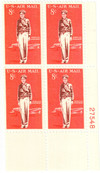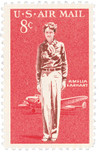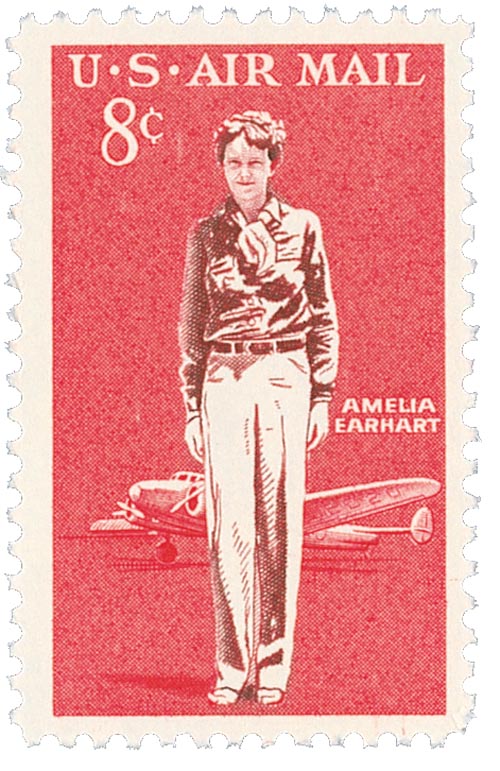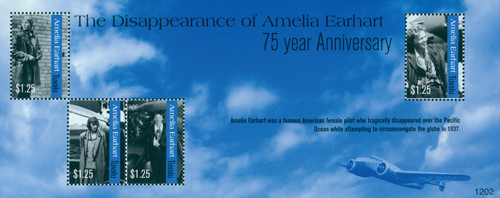
# C68 - 1963 8c Amelia Earhart
1963 8¢ Amelia Earhart
Printed By: Bureau of Engraving and Printing
Color: Carmine and Maroon
Happy Birthday Amelia Earhart
Earhart had a taste for adventure from a young age. In 1904, she saw a roller coaster for the first time during a family trip to St. Louis. When she returned home, Earhart and an uncle built a homemade version and attached it to the roof of a shed. Though Amelia ended up bruised and the wooden box she rode in was destroyed, she exclaimed, “It’s just like flying!”
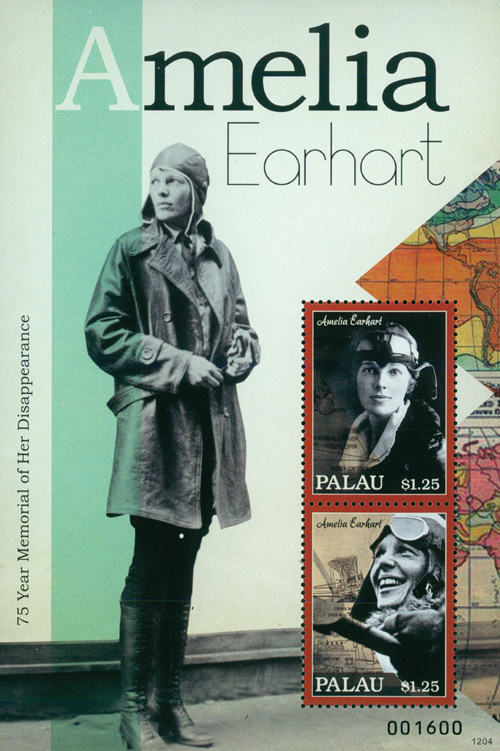
Earhart got a chance to experience a real plane ride in 1920. Her family was living in California and her father paid $10 for a ten-minute flight. Before the plane landed, Earhart knew she had to learn how to fly. She saved up $1,000 and began lessons with a female aviator, Anita “Neta” Snook.
Within six months, the budding pilot bought her own plane. In 1922, she set a world record for females by flying to an altitude of 14,000 feet (over two and a half miles). The following year, Earhart became the 16th woman in the world to be issued a pilot’s license.
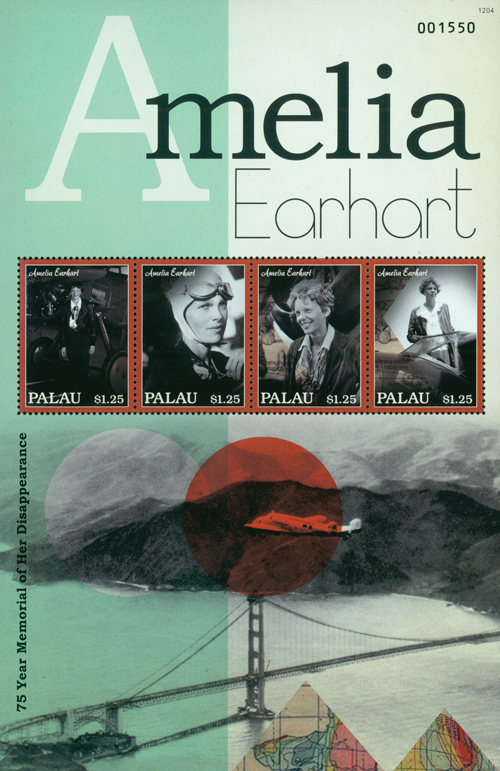
In June 1928, Earhart made history again when she became the first woman to fly across the Atlantic Ocean. Although she was “just baggage, like a sack of potatoes,” as she described her role, she vowed, “maybe someday I’ll try it alone.” The flight made her a celebrity, earning the nickname “Lady Lindbergh” for her close resemblance to Charles Lindbergh. Amelia went on speaking tours and was featured in numerous advertising campaigns. She also founded and served as the first president of the Ninety-Nines, an organization of female pilots.
By 1932, only one other person after Charles Lindbergh had attempted the solo transatlantic flight, a woman named Ruth Nichols, who crashed in Canada. Earhart was ready to try it herself. So on May 20, 1932, she boarded her red Lockheed Vega 5B in Newfoundland, Canada to begin her journey.
Though Earhart had planned to land in Paris as Lindbergh had five years earlier, her plane’s mechanical problems and the bad weather forced her to land elsewhere, on a farm near Derry Ireland. She later recounted of the landing, “After scaring most of the cows in the neighborhood, I pulled up in a farmer’s backyard.” Not only did she complete the flight, but she did it in 14 hours and 56 minutes, a new record time. Upon returning to America, Earhart received a ticker-tape parade and the Distinguished Flying Cross for her achievement.
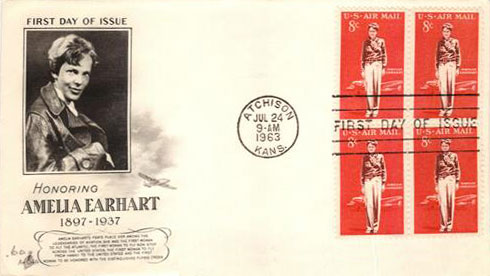
Earhart continued to make record-setting flights. She was the first woman to fly nonstop across the US. In 1935, she became the first person to fly solo from Hawaii to California, from California to Mexico, and from Mexico to New Jersey. As she conquered seemingly impossible challenges, one great test formed in her mind – a trip around the globe.
After a failed attempt, which caused damage to her plane, Earhart and her navigator Fred Noonan took off from Florida on June 1, 1937, flying east. By the end of the month, she had piloted her “flying laboratory,” as she called her plane, about 22,000 miles. The remaining 7,000 miles were over the Pacific Ocean. On July 2, Earhart and Noonan radioed a US Coast Guard ship for assistance in locating a small island. The transmissions were difficult to hear, and they soon lost contact with each other. The plane disappeared and was never found, prompting widespread conspiracy theories for decades.
1963 8¢ Amelia Earhart
Printed By: Bureau of Engraving and Printing
Color: Carmine and Maroon
Happy Birthday Amelia Earhart
Earhart had a taste for adventure from a young age. In 1904, she saw a roller coaster for the first time during a family trip to St. Louis. When she returned home, Earhart and an uncle built a homemade version and attached it to the roof of a shed. Though Amelia ended up bruised and the wooden box she rode in was destroyed, she exclaimed, “It’s just like flying!”

Earhart got a chance to experience a real plane ride in 1920. Her family was living in California and her father paid $10 for a ten-minute flight. Before the plane landed, Earhart knew she had to learn how to fly. She saved up $1,000 and began lessons with a female aviator, Anita “Neta” Snook.
Within six months, the budding pilot bought her own plane. In 1922, she set a world record for females by flying to an altitude of 14,000 feet (over two and a half miles). The following year, Earhart became the 16th woman in the world to be issued a pilot’s license.

In June 1928, Earhart made history again when she became the first woman to fly across the Atlantic Ocean. Although she was “just baggage, like a sack of potatoes,” as she described her role, she vowed, “maybe someday I’ll try it alone.” The flight made her a celebrity, earning the nickname “Lady Lindbergh” for her close resemblance to Charles Lindbergh. Amelia went on speaking tours and was featured in numerous advertising campaigns. She also founded and served as the first president of the Ninety-Nines, an organization of female pilots.
By 1932, only one other person after Charles Lindbergh had attempted the solo transatlantic flight, a woman named Ruth Nichols, who crashed in Canada. Earhart was ready to try it herself. So on May 20, 1932, she boarded her red Lockheed Vega 5B in Newfoundland, Canada to begin her journey.
Though Earhart had planned to land in Paris as Lindbergh had five years earlier, her plane’s mechanical problems and the bad weather forced her to land elsewhere, on a farm near Derry Ireland. She later recounted of the landing, “After scaring most of the cows in the neighborhood, I pulled up in a farmer’s backyard.” Not only did she complete the flight, but she did it in 14 hours and 56 minutes, a new record time. Upon returning to America, Earhart received a ticker-tape parade and the Distinguished Flying Cross for her achievement.

Earhart continued to make record-setting flights. She was the first woman to fly nonstop across the US. In 1935, she became the first person to fly solo from Hawaii to California, from California to Mexico, and from Mexico to New Jersey. As she conquered seemingly impossible challenges, one great test formed in her mind – a trip around the globe.
After a failed attempt, which caused damage to her plane, Earhart and her navigator Fred Noonan took off from Florida on June 1, 1937, flying east. By the end of the month, she had piloted her “flying laboratory,” as she called her plane, about 22,000 miles. The remaining 7,000 miles were over the Pacific Ocean. On July 2, Earhart and Noonan radioed a US Coast Guard ship for assistance in locating a small island. The transmissions were difficult to hear, and they soon lost contact with each other. The plane disappeared and was never found, prompting widespread conspiracy theories for decades.



